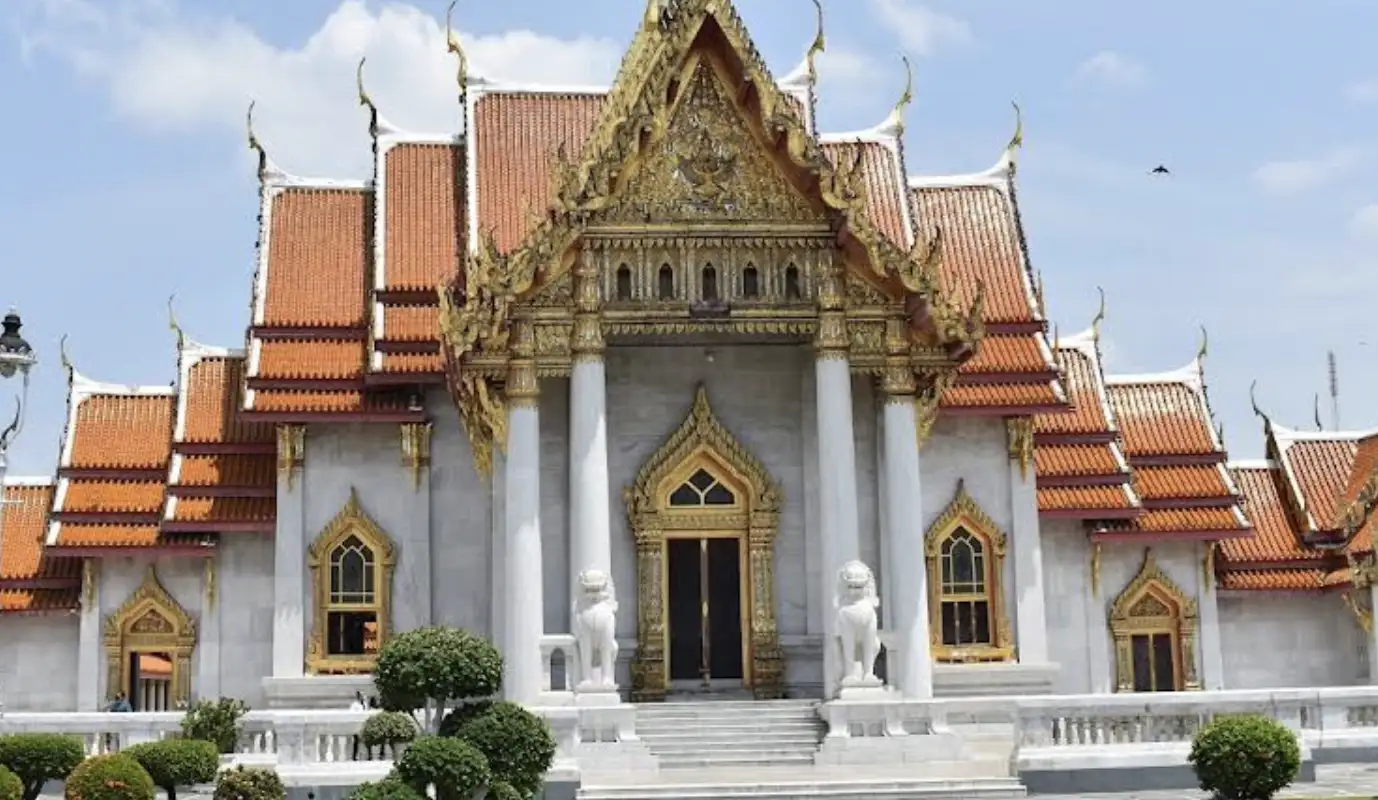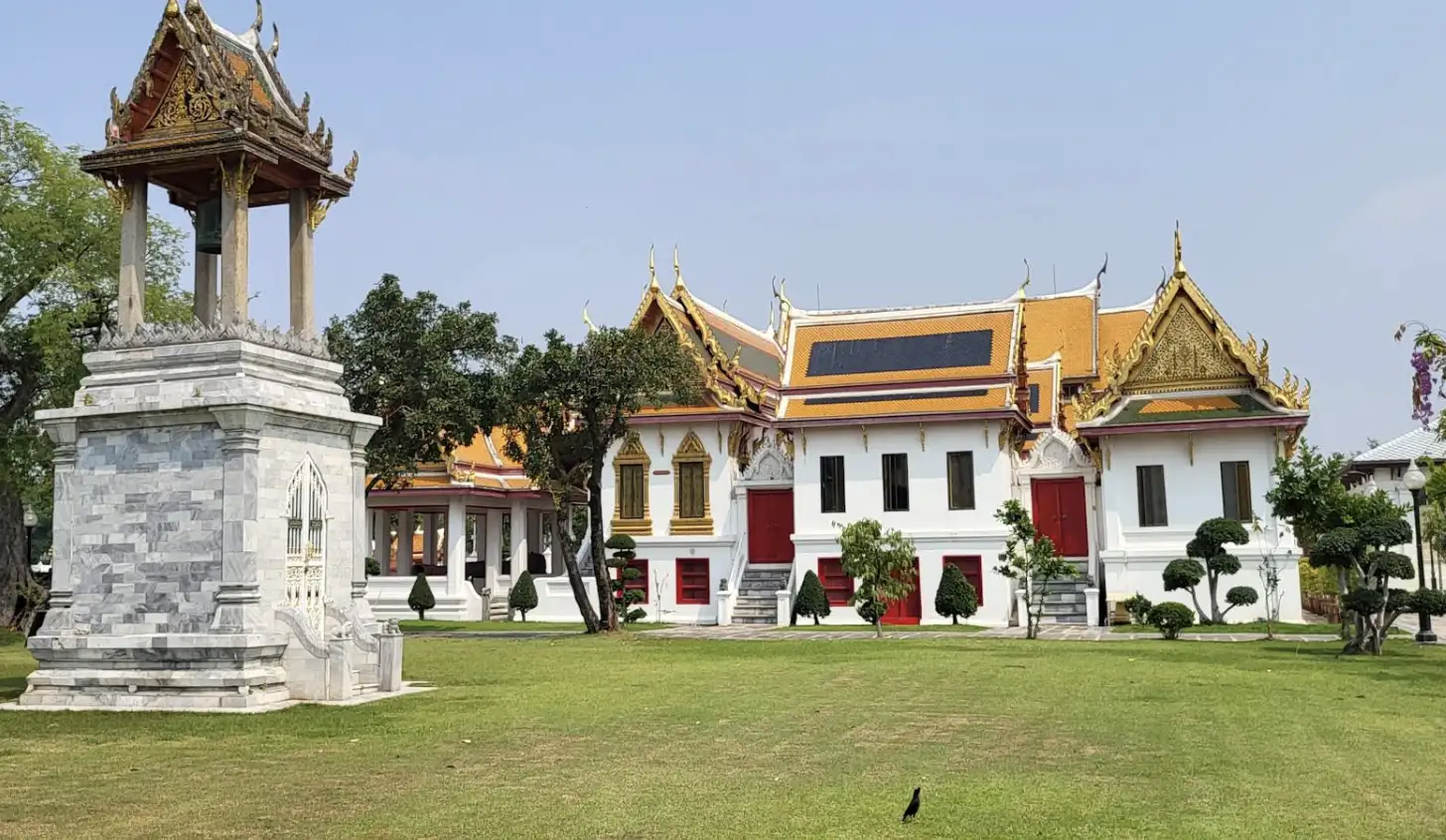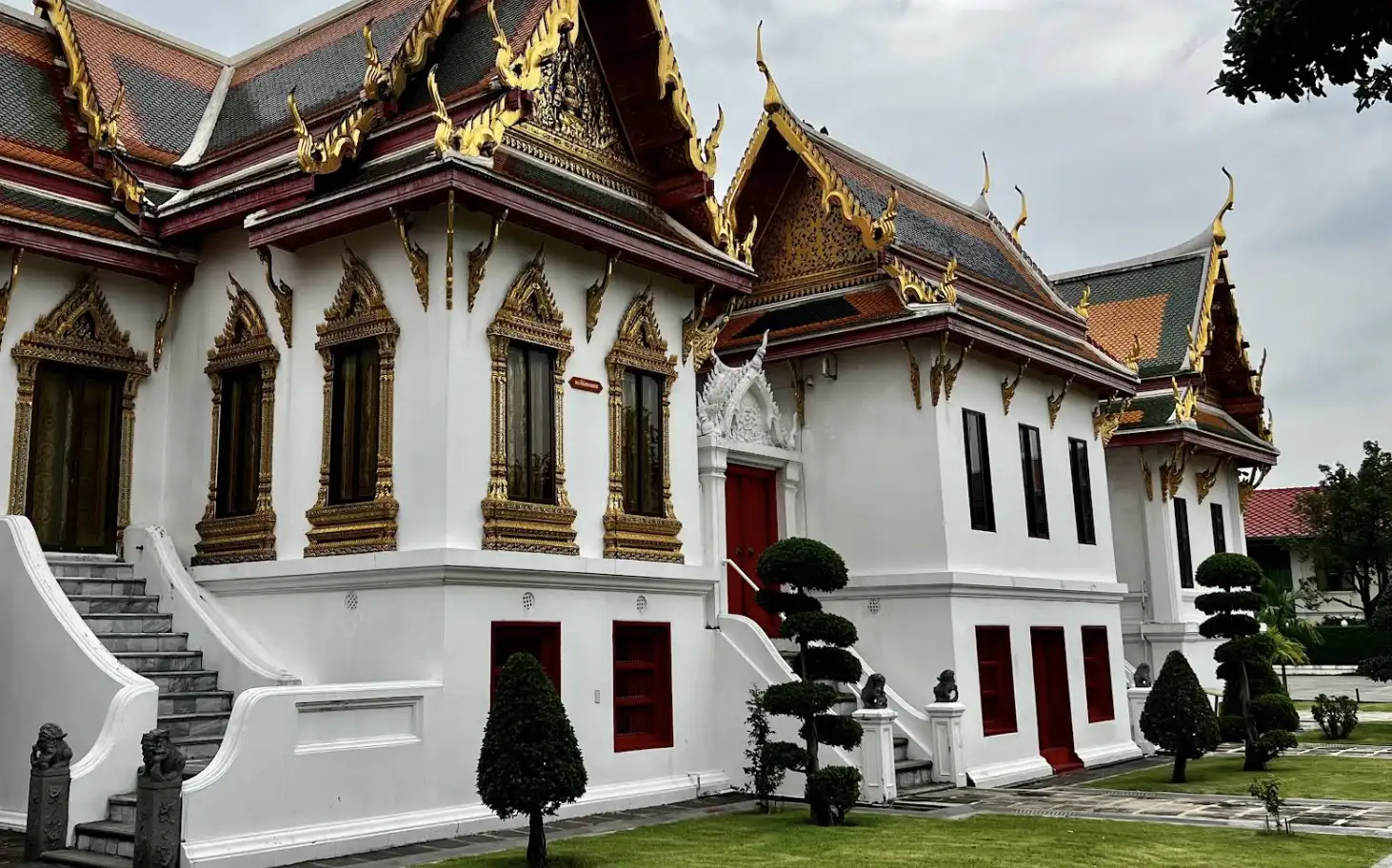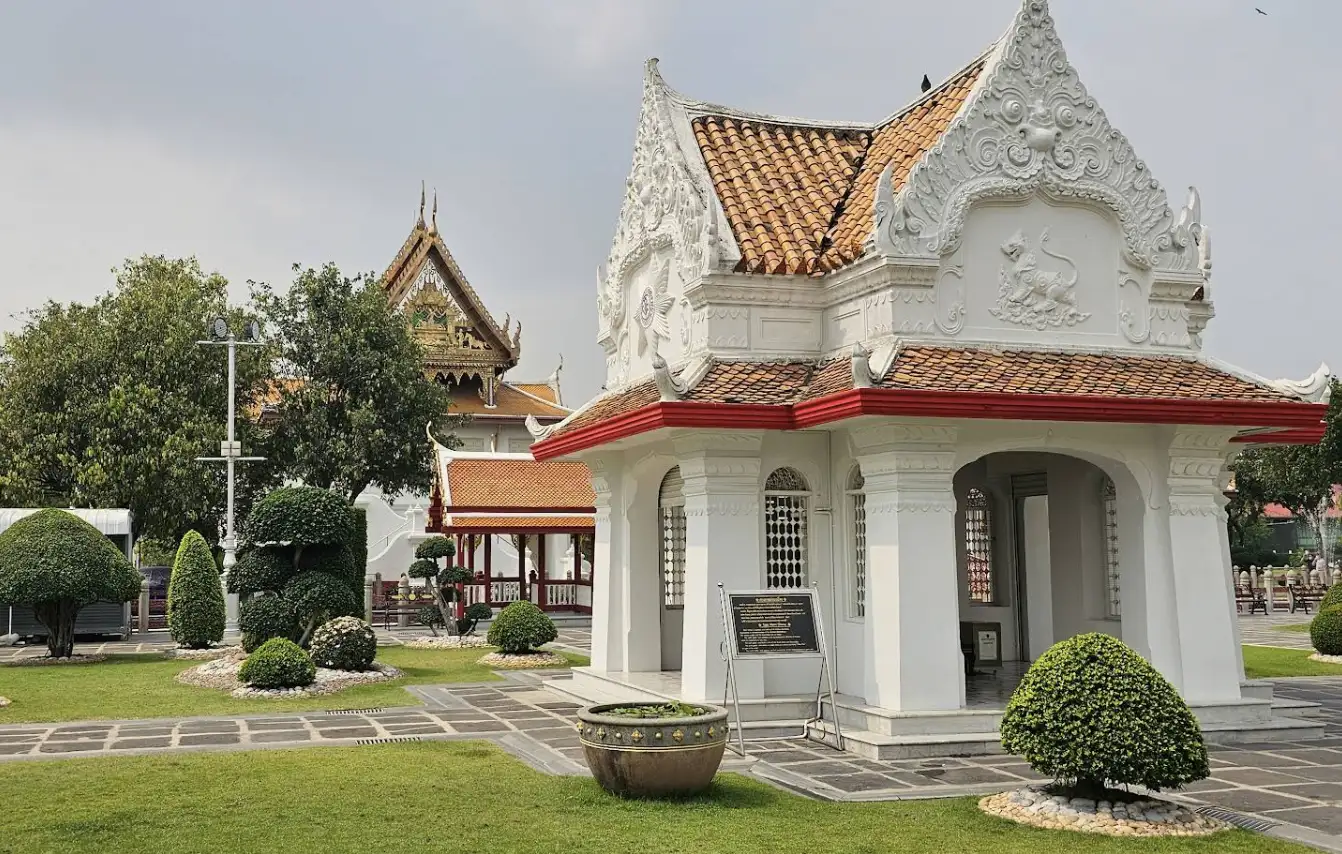As someone who’s been enchanted by the blend of history, spirituality, and architecture that Thailand offers, visiting Wat Benchamabophit—also known as the Marble Temple—was a dream come true. Nestled in the heart of Bangkok, this temple isn’t just another tourist stop on the map. It’s a serene, majestic piece of art that left a deep impression on me, and I’d love to take you through my experience.
First Impressions
I arrived at Wat Benchamabophit on a sunny morning. The sky was bright and blue, and the air buzzed with quiet anticipation. As I stepped out of the Grab taxi, my eyes immediately locked onto the temple’s golden roof, which shimmered in the sunlight. The name “Marble Temple” began to make sense once I noticed the pristine white Carrara marble used throughout the exterior. There was something calming yet regal about the contrast between the white stone and the red and gold roof tiles.
The atmosphere outside was relatively calm compared to other temples I’d visited in Bangkok. There were a few tourists around, but the area didn’t feel crowded. Locals were lighting incense and quietly praying. Monks in saffron robes moved gracefully between buildings. Even before entering, I could sense this was a special place—not just a temple, but a refuge from the chaos of the city.
The Entrance and Courtyard
The entrance gate itself felt like walking into a painting. It’s built in a traditional Thai architectural style, complete with carved gables and mythical creatures guarding the temple. As I stepped through the main archway, I was welcomed by a large open courtyard made entirely of marble. The floor was smooth and cool underfoot, and everything seemed to glow in the morning light.
There are 52 Buddha images surrounding the courtyard, each one representing different mudras (hand positions) and styles from various regions in Thailand and beyond. I didn’t expect to be so fascinated by them, but I found myself walking around slowly, reading the placards under each statue, admiring the subtle differences in facial expressions and posture.
It felt like walking through a living museum.
The Main Chapel (Ubosot)
When I finally entered the main ordination hall, or ubosot, I was speechless.
This is where the heart of Wat Benchamabophit beats.
The Buddha statue inside—called Phra Buddha Chinnarat—is a bronze replica of the famous original in Phitsanulok. It’s seated in a position of victory, and behind it is a golden backdrop that seems to illuminate the statue with a divine glow. The way the light filters in from the windows and reflects off the polished marble floors creates a sacred, almost otherworldly ambiance.
I sat down quietly on the floor, alongside a few other visitors, and just breathed in the peace of the place. There were no loud voices, no camera flashes—just the soft sound of bells in the distance and the occasional murmur of prayer.
As someone who isn’t Buddhist but respects the spirituality of places like this, I found the experience deeply grounding. I didn’t have to understand every ritual to feel the stillness and reverence in the room.
Architecture and Design
Wat Benchamabophit was commissioned by King Chulalongkorn (Rama V) in the late 19th century, and you can feel the royal influence throughout the design. It’s one of the best examples of modern Thai architecture fused with Western techniques. The Italian marble, the symmetrical layout, and the stained glass windows all hint at European influence—but the soul of the temple remains unmistakably Thai.
I was particularly drawn to the multi-tiered roof adorned with golden chofas (ornamental finials that look like bird beaks) and the intricate carvings that decorated every surface. Every corner, every window, every beam was made with care and precision. It’s the kind of place where you keep discovering new details the more you look.
Even the ceilings are a work of art—painted in rich reds with gold patterns. It’s impossible not to keep looking up.
The Monk’s Quarters and Surrounding Grounds
One of the unique aspects of Wat Benchamabophit is that it’s not just a tourist attraction—it’s a living monastery. There’s an active monk community here, and you can often see novices walking around or engaging in daily chores.
I spent some time walking through the nearby garden paths, and I even saw a group of monks meditating near a pond filled with lotus flowers. It felt like I was observing a different rhythm of life—slower, more intentional, and deeply connected to spiritual practice.
There’s also a beautiful canal that runs alongside the temple grounds. I sat there for a while, letting the calm water and gentle breeze help me soak in everything I’d seen so far.
Spiritual Reflection
While I’m not a religious person in the traditional sense, Wat Benchamabophit gave me a space to reflect on my own journey. There’s something about sacred spaces like this that transcends language and belief systems. I didn’t need to be Thai or Buddhist to feel moved by the silence in the main chapel or the devotion of people lighting incense.
I wrote a few lines in my travel journal while sitting on the marble steps of the courtyard. Something about this place reminded me to slow down, to breathe, and to be present.
Practical Tips for Visiting
If you’re planning to visit Wat Benchamabophit, here are a few things I learned that might help you:
- Dress appropriately: This is an active temple, so modest clothing is required. I wore long pants and a light blouse with sleeves.
- Go early: I arrived around 9 AM, and it was quiet and peaceful. By 11 AM, more tour groups began to show up.
- Entry fee: As of my visit, foreigners are charged 50 baht. It’s well worth it.
- Photography: Photos are allowed in most areas, but be respectful—especially inside the chapel.
- Combine with other temples: Wat Benchamabophit is not far from Dusit Palace and Wat Intharawihan, so you can make a half-day trip of it.
Final Thoughts
Visiting Wat Benchamabophit was more than just seeing a beautiful temple—it was an experience that touched me deeply. It combined everything I love about travel: stunning architecture, cultural depth, spiritual richness, and a sense of peace that stays with you long after you leave.
In a city as vibrant and chaotic as Bangkok, this temple offered me a quiet sanctuary. A place to pause, observe, and feel something beyond words.
If you ever find yourself in Bangkok and want to see a temple that’s both visually stunning and spiritually moving, I can’t recommend Wat Benchamabophit enough.
It’s not just a place to visit—it’s a place to feel.




